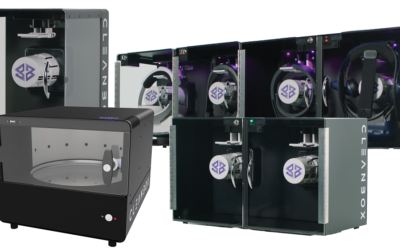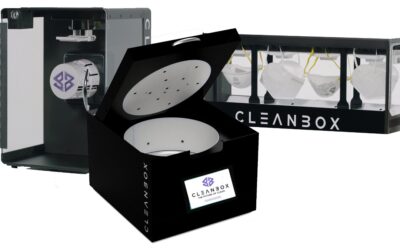In recent years, a significant number of educational institutions have started using VR headsets to increase the efficiency of training. With the help of VR, students can experience a wide range of environments and events without having to travel. However, headsets can be expensive, so they have to be shared. A UV-C sanitizer box like CleanBox can effectively remove 99.999% of pathogens from electronic devices.
UV sanitation is efficient and cost-effective, so it can be implemented in a wide range of settings. Because the disinfection process is very easy to implement, it’s ideal for educational institutions because the flow of the class won’t have to be interrupted. Today, we’ll have a closer look at how UV cleaning works and why it is a much better choice than traditional methods such as wiping down equipment.
VR in the Classroom: How to Develop an Effective Sanitation Plan for Shared Devices
Developing an effective sanitation plan starts at the top, with the leaders of the educational facility. Managers and coordinators have to decide whether UV cleaning is right for their organization and, if so, get in touch with product experts who can explain how the device works and which box is best for the organization in question.
Once the sanitation device has been purchased, it has to be installed in the relevant classroom, and teachers have to be educated. Depending on the size of the class, VR devices can either be sanitized by the teacher or each student can use the UV box on their own. Because the process is very simple and takes only 60 seconds, everyone can learn how to use the box, and no advanced training is required.
Why Not Use Wipes?
During the early stages of the COVID-19 pandemic, people sanitized equipment using antibacterial wipes. But there are several reasons why these aren’t as effective as a UV-C box. Firstly, VR devices often have complex surfaces, so it’s hard and time-consuming to disinfect them with a towel, and there is no guarantee that the whole device has been decontaminated. What’s more, some of the materials are porous and can’t be wiped down effectively.
Another major problem with wipes is that they cause a lot of pollution. Since the pandemic, thousands of tons of plastic have been dumped into landfills and oceans due to people’s increased disinfection efforts. This can be avoided with the use of a UV box, which doesn’t produce any waste and only uses a small amount of electricity.
What Are the Advantages of Using the CleanBox UV-C Sanitizer Box?
For schools and colleges, there are many advantages to using a UV sanitizer device. Not only is this type of disinfection more effective, but it is also faster, so it doesn’t disrupt the flow of the classes.
If an organization expects to use VR headsets for many years, purchasing a box is an effective way of reducing the institution’s running costs because each sanitization cycle is extremely cheap. What’s more, schools and colleges can reduce their environmental impact and become sustainable more quickly with UV sanitation.
High Efficiency
One of the most important benefits of using UV light to sanitize devices is that this method is 99.999% effective at deactivating both viruses and bacteria. In contrast, many wipes are only approved for bacteria, so there’s no guarantee that they also attack viruses. What’s more, it’s much easier to clean the Velcro or cloth straps with a UV-C device because the porous nature of these materials makes wiping them very inefficient.
Low Cost Per Cycle
At first, purchasing a UV-C sanitizer box might seem like a large expense because the devices cost several thousands of dollars. However, it’s important to consider the longevity of this product. The UV boxes sold by CleanBox are made using UV-C LED light engineering technology. These light-emitting diodes are much more effective than traditional bulbs, and they don’t break down quickly, even when they are used multiple times a day.
On average, users can expect one box to last for 10,000 hours, which is the equivalent of over 500,000 cleaning cycles. Because most boxes can sanitize multiple headsets at one time, this is equal to millions of individual disinfection processes. Continually purchasing wipes would be more expensive. Additionally, the UV light doesn’t damage the headsets, while repeatedly wiping down the equipment with harsh chemicals might wear it out more quickly.
Environmentally Friendly
As mentioned, plastic waste has become a major problem in many areas of the world, and sanitation with wipes or sprays is contributing to the issue. If every educational institution adopted UV cleaning instead of wiping down equipment, many tons of waste could be avoided. The sanitation box lasts for years or even decades, and it doesn’t require the use of any disposable parts. Instead, each cleaning cycle only uses up a small amount of electricity.
Additionally, the UV boxes are made with LED, which are produced in a more environmentally friendly way than traditional bulbs. They don’t require the extraction of any heavy metal, and they don’t produce toxic waste that has to be disposed of carefully. Businesses and schools that are working to reduce their ecological footprint should consider using UV disinfection instead of toxic wipes.
Less Disruptive
Teachers holding a training session that requires the use of VR will have to disrupt their session every time the headsets have to be sanitized. Because handing out the wipes, wiping the equipment thoroughly, and disposing of the wipes can take five to ten minutes, this reduces the effectiveness of the training.
UV disinfection is much simpler and quicker. The person who has worn the device can simply place it inside the box, select the correct headset and cleaning cycle, and run the program. One minute later, all harmful pathogens have been deactivated, which means that their genetic material has been destroyed, and they can no longer reproduce. The headset can then be handed to the next person, who can use it safely, without worrying about contamination.
Which Box Is Right for Me?
Because a UV box is a significant investment, institutions should speak to a product specialist before making their purchase. There are several options, each designed with a different purpose in mind. For example, the OmniClean is suitable for both smaller and larger items, while the CX Series has been created specifically for head-mounted displays like headsets and earphones.
There are also different sizes to choose from. The smallest boxes can only sanitize one object at a time, while the larger ones can decontaminate multiple headsets at once. Institutions should consider whether VR devices will be used in several rooms or in just one media room. If the former is the case, purchasing several smaller boxes would make sense, but if VR classes are limited to one room, one large sanitizer box might be enough.
The easiest and most efficient way to sanitize VR devices in a school or university is with the help of a UV-C sanitizer box. This device can deactivate 99.999% of pathogens within 60 seconds, and it is easy to use for teachers or students. What’s more, the UV box is environmentally friendly and cheaper in the long run than wipes.





